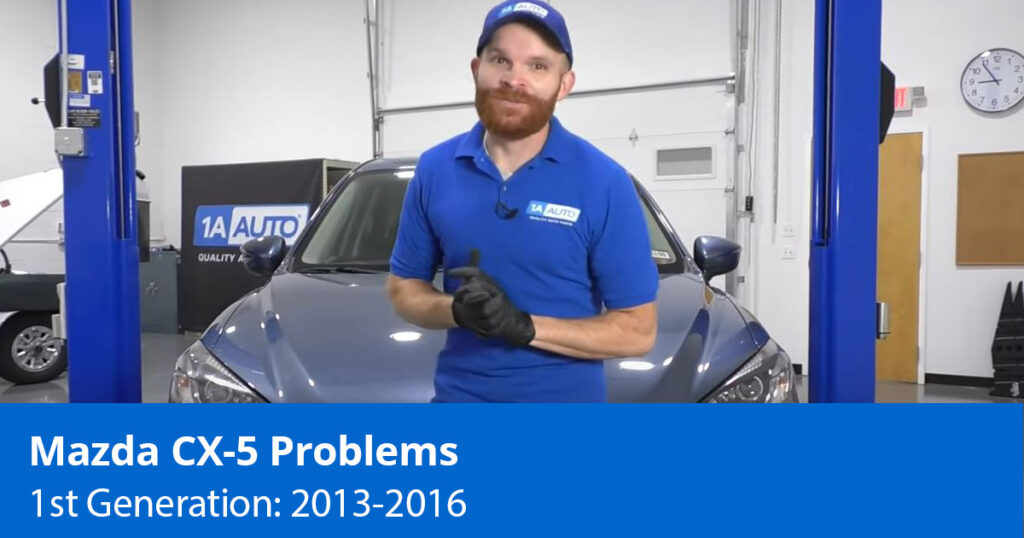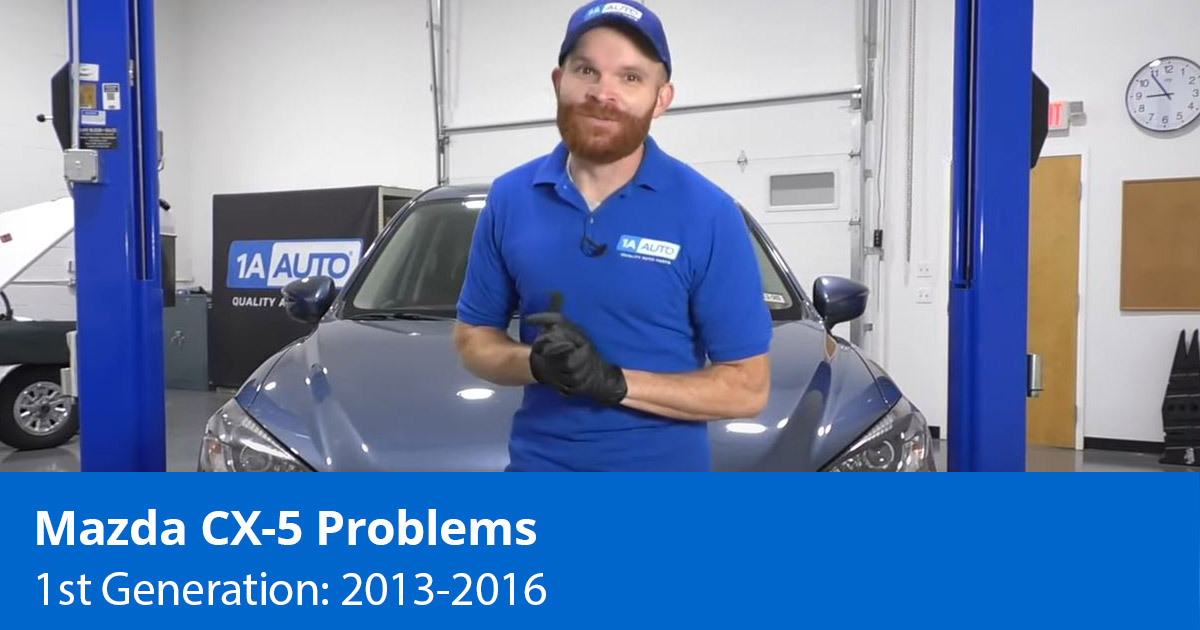
How to Diagnose Your 2013-2016 Mazada CX-5 Problems.
These are the top 5 problems with the 1st generation of the Mazda CX-5 SUV, which is available as model years 2013 to 2016. If you own or are planning to own one of these SUVs, this article will show you the most common Mazda CX5 problems that you should keep an eye out for! Len also gives you advice on how you can resolve these problems yourself.
Top 5 Mazda CX-5 Problems (2013-2016)
1. LED Daytime Running Lights
The first-generation Mazda CX-5 comes with a strip of LED daytime running lights that runs from the side of the headlights and forms a U-shape towards the front. The lights are designed to operate at low power anytime your vehicle is running and work separately from the headlights.
Sometimes, moisture tends to get through the headlight and into the small circuit connected to the LEDs. This causes corrosion that eventually stops the lights from working. Mazda released a statement in regards to this and said the problem was caused by improper materials used to make the ceiling gasket.
When moisture passes through, it damages the LED light circuit, which then causes the lights to flicker or stop working altogether. This can happen to one headlight or both. If you’re the hands-on type, you can always take the headlight assembly apart and clean out the corrosion. You may be forced to replace the entire headlight assembly if the problem is severe.
2. Windshield
It’s not uncommon for the Mazda CX-5 windshield to crack due to stress. This can happen while you’re driving down the road. You’ll mostly hear a creaking or popping sound within the cabin that tells you something made of glass is cracking slowly. The cracks normally occur right above where the windshield attaches to the roof.
If it’s not taken care of in good time, the crack can spread throughout the windshield. You want to be on the look-out for small chips that may eventually become large cracks. The best solution here is to replace the windshield. Some owners report having the problem reoccur while others say a good replacement solved the problem.
3. Liftgate Support Pistons
The liftgate support pistons use gas or liquid to provide the energy required to raise the car’s liftgate. On the Mazda CX-5, they can sometimes experience leakages. This weakens them and makes them ineffective when it comes to holding the liftgate in its open position. It may, therefore, come bonking down on you when you’re putting in your groceries.
On certain occasions, you may be forced to hold it up with your hand or prop it up with something. The pistons wear out over time and to fix the problem, you’ll need to unbolt the old ones and replace them. Remember to replace them in pairs. If you replace just one, the other may not be that far off from breaking down too.
4. Rear Brakes
If you take a look at the rear brakes fitted on your Mazda CX-5, you’ll be able to see the brake rotor, the pads, and the brake calipers. What happens with these Mazda CX-5 brake components is that they do not wear out evenly. The brake pads are known to wear out faster than the rest of the other components. You’ll need to service or replace them together with the rotors if the latter are also too badly off.
The reason why the brake pads on the Mazda CX-5 wear out faster is because they are supported by caliper brackets that feature supporting tins. The tins are fitted directly on the caliper bracket, providing a metal-on-metal contact area. Moisture tends to make its way in between the contact, pushing out the bracket tins little by little.
Brake Pads Should Be Able to Move
This prevents the brake pads from sliding in and out as required. The result is a brake pad that is too stuck inside the bracket to fluctuate like it’s supposed to. More than likely, it will continue to stick further onto the rotor as you continue to step hard on the brake. This prevents the pad from releasing when you lift your foot off the brake.
To fix this problem, you’d have to take apart all the brake components and do a visual inspection of each. If the brake pads and rotor look fine, clean off any rust and debris that may have accumulated in between the caliper brackets and the tins. You can use a sanding disc or wire brush for the job.
Remember to add some Moly grease in between the surfaces to prevent the build-up of moisture. If by any chance you need to replace the brake pads, it’s always a good idea to replace them all at the same time.
Another thing to note is that the Mazda CX-5 has an electronically controlled emergency brake system that may make it difficult for you to push in your rear caliper pistons. You’ll need to put your brakes in “Service Mode” to make the job easier.
5. Electronic Parking Brake Module
Like most modern vehicles, the first-generation Mazda CX-5 comes with electrical systems and several modules that improve its functionality. The electrical parking brake is a technological advancement that allows you to engage your parking brake without having to step on a pedal or grab onto a knob. All you need to do is push a button.
The system utilizes an electronic module that sends power to the drivers found right on the calipers. This helps to activate the emergency brake by pushing the calipers so that they can hold the rear brakes. If you’re having a problem with the electronic park module, some of the symptoms that you’ll notice include noticing the EPB light on your dash come on or having a parking brake that’s stuck.
You may also feel a drag when you try to accelerate from your parking spot or pulsation when you step on the brakes. Other symptoms include noticing a burning smell coming out of your rear brakes or having a parking brake that doesn’t work at all.
The Emergency Brake Locks up
On rare occasions, some owners have reported having the emergency brake lock up while the car is moving. This causes an overheating condition, especially where the parking brake is stuck in the ON position. You may also feel the brake pulsate when you come to a stop.
All these Mazda CX-5 problems will almost always come down to a bad electronic parking brake module. Other times, it may be caused by bad brake calipers. The first step to fixing the problem is to pull out the diagnostic codes whenever the EPB light pops up on the dash. Once you’ve confirmed that the problem is indeed with the electronic parking brake module, disconnect your negative battery terminal and leave it off for a couple of hours.
This allows the module to rest. Reconnect it afterward and go for a test drive. This might work to temporarily fix the problem. A more permanent solution would be to replace the EPB module altogether. This will cost you anywhere around $900 or more.
Parts for First Gen Mazda CX-5
Articles Related Top Mazda CX-5 Problems:
- Nissan Versa Problems 2nd Generation (2012-2019)
- Infiniti G35 Problems: 3rd Generation (2003 to 2007)
- Top 5 1st Gen Sequoia Problems: 2001 to 2007
- 3rd Gen Tacoma Problems
- Top 5 cars that you MUST own at some point in life.
- Common Cadillac STS Problems: 1st Generation (2005 to 2011)
- Common Honda Pilot Problems: 2nd Generation (2009 to 2015)


Why no mention of the brake light switch?….
Our was replaced under warranty…..
And is bad once again already